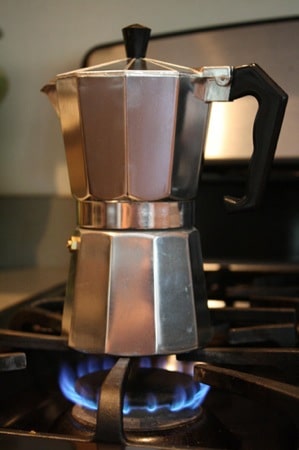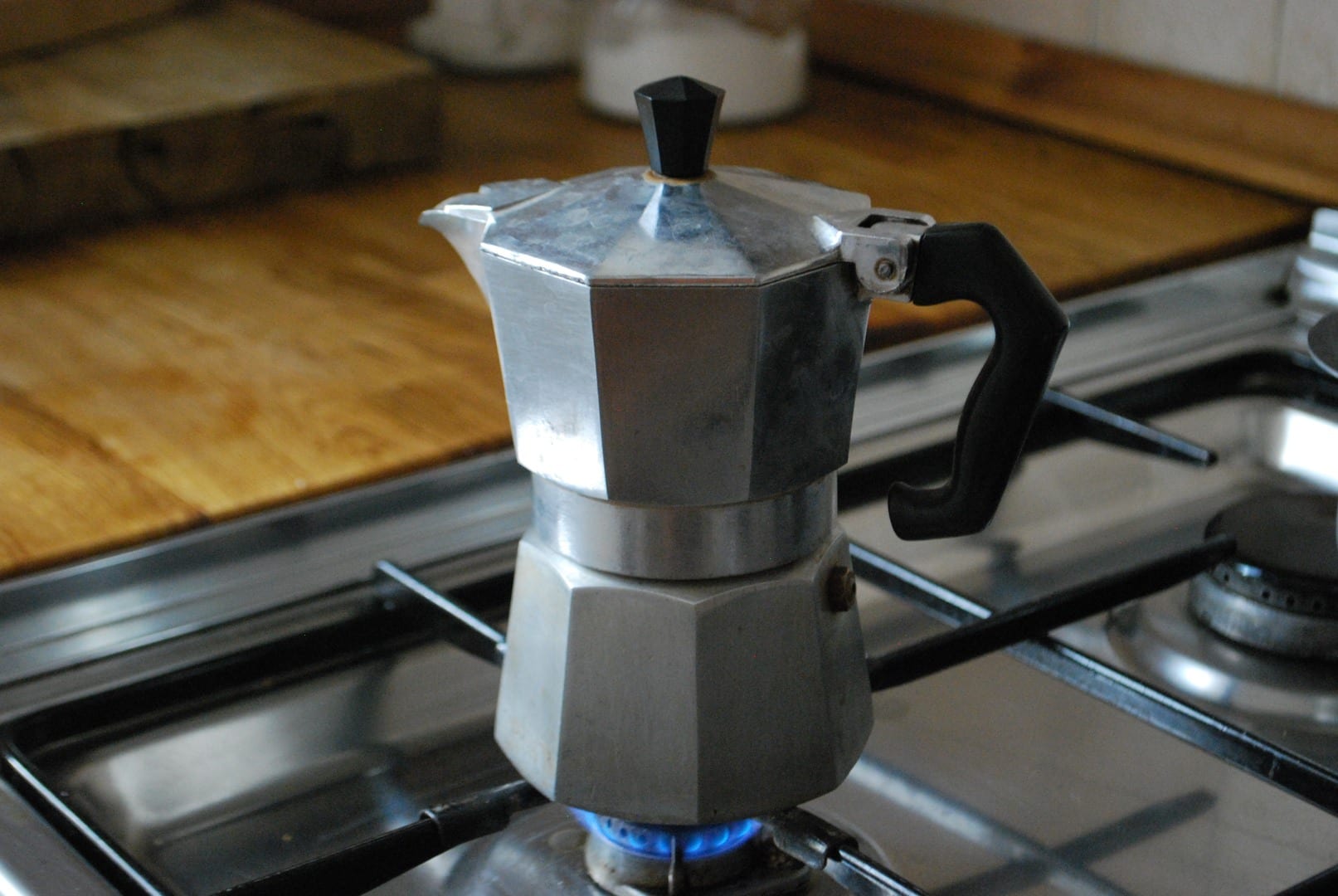Moka pot
The espresso pot, Italian Caffettiera, is a coffee percolator and coffee-making facilities used on a stove.
The model with the facets is the Moka Express, which was developed by Alfonso Bialetti and manufactured only after 1945, soon attracted other suppliers from Italy. These cans are to refer to the shape largely identical to the models of the pre-war period, as they were made in France, Austria and Hungary. Today, there are the espresso pot made of stainless steel, which gives it a longer shelf life and allows other designs. It is manufactured in different sizes, given as the number of coffee cups (60 ml), the maximum can be prepared with a filling.
The discussion about the "wrong" name
The ( used only in Germany ) Name espresso pot is misleading because no espresso can be made with it: The pot produces a maximum pressure of about 1.5 bar, for the preparation of espresso, however, a brewing pressure of about 9.0 bar is required, as produced by espresso machines. Apart from the different taste even a layman can tell the difference between a properly prepared espresso and a cooked with the pot of coffee quickly: including because of the lower pressure is formed during the preparation of espresso pot no stable crema.
A " more correct " designation ( as they use the Italians ) would therefore be moka pot (her original name ). This in turn makes for more name confusion because often referred to as "mocha " misunderstood - what is known around the world have another coffee type, namely the Arabic, Turkish or Greek prepared mocha.
In Austria, where coffee percolators are made of aluminum since the beginning of the 20th century, the pot mocha machine is called, what initially appears consistent, because once the espresso is sometimes called mocha. A closer look at the description implies in their language environment but also misleading.
In Italy itself, the device next to Bialetti Moka or colloquially often called simply Caffettiera This simply means coffee pot and is also used for other devices of coffee preparation. Also, the product made with it is simply referred to as Caffè, just like the "real" espresso. As is customary in Italy to prepare at home the coffee with the moka pot, on the other hand go for a coffee in a bar, the relative importance of Caffè from the context emerges: At home, this means, prepared with the pot of coffee, outside the home, this is the Caffè espresso.
Design and function
An espresso pot consists of three parts. Can The lower part ( 1 / A) or boiler is filled with water. In the funnel insert (2 / B) the coffee powder is added, and the Can upper part (4 / C) with a dip tube (3 ) catches the finished coffee. When heated on the hotplate, the water in the boiler starts to evaporate. This creates a positive pressure that pushes the hot water in the boiler through the coffee powder in the funnel insert. The coffee then flows through a fine screen at the bottom of the can shell, and rises in the riser runs from the top of the can shell.
If the espresso pot clogged, the water vapor escapes through a safety valve ( 5) on the boiler. After the preparation is always some residual water in the boiler, which prevents an immediate overheating. Nevertheless, you should always take the pot off the stove in time, so that the coffee does not begin to boil in the can top. When closing the two halves should Can not take the leverage of the handle to help you. Over- sealing the rubber gasket wears out faster, and you can thereby damage the threads and re-opening difficult.
Use
- First, the coffee pot is unscrewed and removed the funnel insert.
- Now the boiler is filled with water. The amount of water may be varied as desired;
However, the safety valve may not be covered by the water.
- The funnel filter is used again and filled with coffee powder. The powder is compressed usual with a masher not like Espresso Machines Espresso Machines.
Using a reducing screen, which accompanies many coffee-makers today half the amount of coffee can be prepared.
- The can top is screwed back tight.
- Now the coffee pot is placed and heated on the hotplate. Aluminum cans are on induction hobs not hot, since aluminum is not magnetic.
- Starts to boil the water, the upper part can fill with coffee. At the end you can hear a distinct hiss because now vapor in the riser pipe.
The pressure
The pressure with which the water is pressed through the coffee grounds, depending on density and granularity of the coffee grounds from ( this has an additional filter function). The safety valve ( 5) in the can bottom part (1 ) limits the maximum pressure to 1.5 bar and in extremely fine and highly compressed ground material can be in the lower boiler to build up a pressure that is so high that the valve responds and the vapor in the ambient air allowed to escape. Other hand, escapes water via the screw thread of the two halves can, the can was not securely tightened or the gasket is defective.
The temperature of supply
The higher the temperature, the faster the water is pressed through the coffee, since with a higher energy supply, the temperature curve is steeper. The water temperature at which the coffee is extracted, an increased supply of energy has less influence, because the resultant increase in pressure will change the boiling point only slightly. The water permeation rate through the coffee powder determines the extraction time and therefore has a decisive influence on the solution of the flavor and tannins. The Kaffeegranularität is therefore adjust the desired water permeation rate and vice versa ( cf. filter coffee): the water flows too quickly through the funnel insert, the coffee was too coarse or the funnel insert inadequately filled under circumstances and the coffee develops too little flavor. To finely ground coffee powder in the hopper or to use highly compressed powder, however, leads to bitter or burnt tasting coffee.
To Crema
The classic espresso pot can not or only slightly volatile crema produced.
However, there are improvements that have a pressure relief valve at the upper end of the riser. This pressure relief valve is also called Cremator or crema valve and holds back the water in the boiler, until a certain pressure (up to 6 bars ) is reached. Only at this pressure, the coffee is forced through the Cremator, whereby the coffee is replaced by a more stable crema.
Arguments against the aluminum pot
Under toxicologists and Trophologen there is disagreement to what extent the classical aluminum cans leave a residue in the drink, which would be unhealthy and can negatively affect the taste. A bad treatment of the aluminum surface can actually lead to such residues, as scratches, salt and alkali attack the aluminum, then it is even possible on tea towel to prove residues. It is questionable to what extent such any residues etc. significantly increase the daily intake of aluminum from food, medicines. The strong alkaline liquor in the dishwasher leaves ( unpainted ) aluminum blacken, and aluminum parts in the dishwasher result in poor wash results with all other Spülgegenständen same charge. Alternatively cans made of stainless steel are available. Traditionally, the pot and its parts are rinsed with water without additives. So it comes with bases not in contact and sets on their characteristic patina.
For induction cooktops each Cookware is unsuitable with aluminum floor. Alternatively cans are available in stainless steel or with a double bottom that are labeled as suitable for induction.
Gallery
Filled upper part can
Semi-open version of the espresso pot: The coffee flows directly into the cups.
Espresso pot with attached Cremator to improve the crema ( Bialetti Brikka ).










